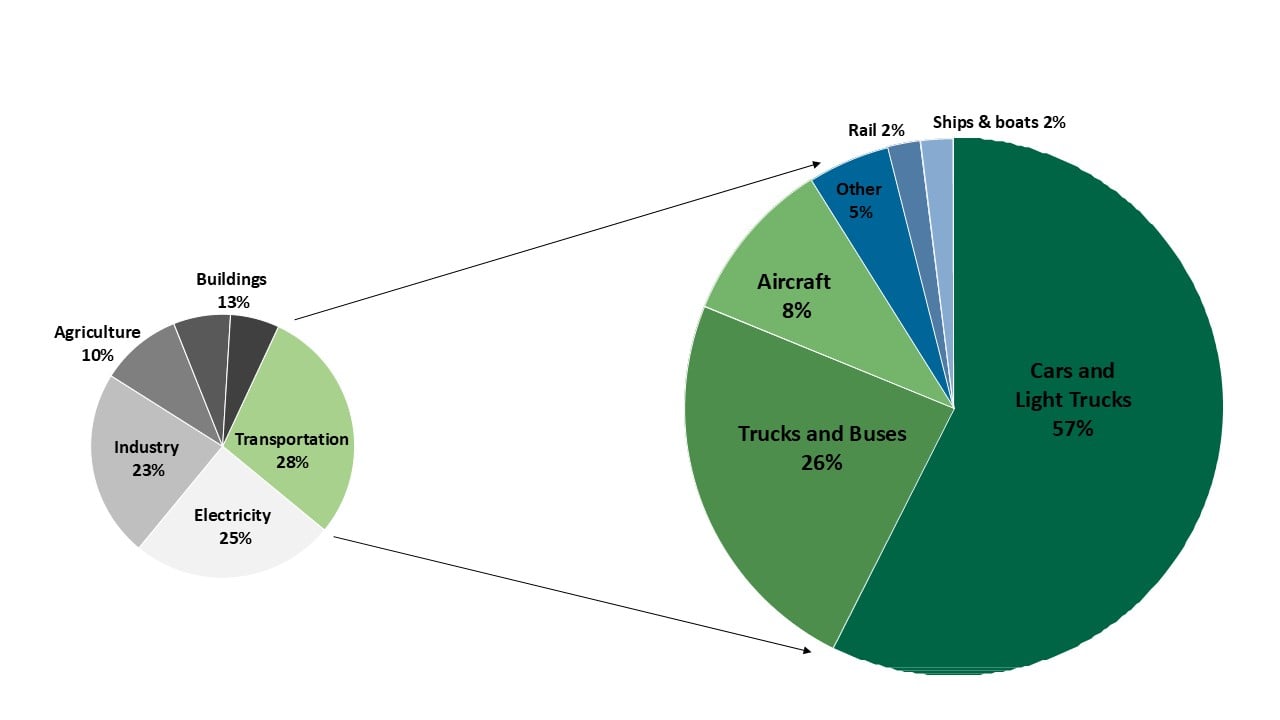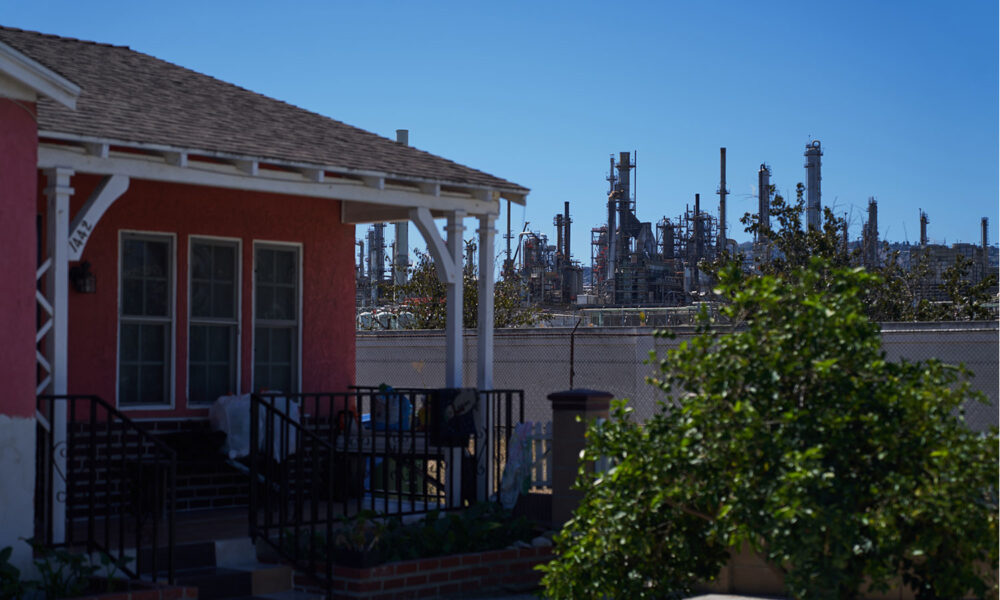Many of us have driven by a refinery and witnessed the sprawling and dystopic-looking installations that produce the gasoline, diesel and jet fuel that power our vehicles, and other petroleum products such as asphalt for our roads. You might have smelled the invisible toxic pollutants in the air and rolled up your car windows. Tragically, many refineries are located near highways and places where people live, work, go to school and do errands. Many people, including refinery workers, have no choice but to breathe that foul air day after day, year after year.
While some who drive past these refineries don’t have to live near them or work in them, those who do can be harmed by the well-documented effects of refinery pollution on human health. The fossil fuel industry has systematically contaminated our environment with a wide range of toxic chemicals for over a century. The entire supply chain—exploration, drilling, extraction, refining, distribution and consumption of its products—contaminates our air, water and soil, but there are many reasons to pay close attention to the emissions from refineries.
- Refineries endanger the health of billions of people around the world, contribute significantly to inequity and seriously degrade the planet’s ecosystems.
- They are often located near urban centers and highways, affecting fenceline communities continuously, as they run 365 days a year and occupy land which can be as large as several hundred football fields.
- Refineries are among the most toxic industries in this country. Based on data from the Environmental Protection Agency (EPA) on toxic air and water emissions for a large number of industrial facilities across the US, refineries are the 10th most toxic industry, in a toxicity ranking list with over 200 grades. Many pollutants cause cancer, pulmonary and heart diseases, neurological, reproductive, developmental, and immunological damage, and more. Examples are benzene, hydrofluoric acid, particulate matter, sulfur dioxide, nitrogen oxides, and many, many other toxic pollutants.
- Refineries have the highest rate of pollution in the oil industry, including air, water and soil pollution.
- Refining uses many risky industrial processes. Refinery workers are subject to high rates of injuries and death from accidents and malfunctions. Between 2017 and 2023 there were over 1500 injuries and seven deaths in 153 refineries across the US.
The nexus between refineries, transportation and global warming
My objective here is to talk about local pollution and health but first I want to look at the impact of a refinery’s main products—liquid fuels—on global warming pollution. The gasoline, diesel and jet fuel used by our dirty transportation system is what makes up the majority of refinery products: gasoline, diesel and jet fuel account for 84 percent of refinery products. It is therefore the energy used in the transportation system that contributes the most to global warming, more than the power, industrial and building sectors. In 2022, the transportation sector was responsible for 28 percent of global warming pollution in the country. If we look at just the transportation emissions that year, more than 80 percent came from burning fuels in cars, trucks and buses1, while the rest came from aviation, shipping and other forms of transportation. See the pie charts below.
2022 U.S. GHG Emissions by Sector

Climate changes pollution and pollution changes climate
Another reason to look at the global warming impacts of refineries from a health perspective is that there is an important link between global warming and local pollution.
Fossil fuel combustion produces carbon dioxide (CO2), the most abundant global warming pollutant, but also produces local pollutants such as fine particulate matter (PM2.5), nitrogen oxides (NOx), carbon monoxide (CO) and volatile organic compounds (VOCs). Since global and local pollutants are often byproducts of the same activities, mitigation policies for global warming emissions have the potential to simultaneously mitigate local air pollution2.
One good example of the nexus between global warming and local pollution is ground-level ozone. It not only traps heat in the atmosphere, contributing to global warming, but the warmer temperature resulting from global warming leads to an increase in ground-level ozone, since ozone is produced indirectly from precursors like NOx and VOCs in the presence of sunlight.
Because of the complexity of atmospheric chemistry, there may be unexpected links between global warming and local pollution, so policies must address both kinds of pollution keeping in mind the latest science on how they are connected.
Refineries emit a mix of dozens of toxic pollutants
Refining crude oil into gasoline, diesel and jet fuel, and other products of high economic value, results in the emission of many toxic pollutants. One of the reasons is that refining processes are more complex than those in most industries. They use high heat, high pressure and a vast array of chemicals to separate the crude oil into parts, remove corrosive sulfur compounds and create new compounds. One study reported 188 chemicals, of various levels of toxicity, emitted from California refineries at various times. Toxic pollutants are emitted from equipment and storage leaks, accidental releases, and refining processes3, especially high-temperature combustion processes.
The oil and gas industry is the largest industrial source of hazardous air pollutants
Refineries are major emitters of hazardous air pollutants such as benzene, toluene, xylene, hexane and other toxic compounds such as hydrofluoric and sulfuric acids, heavy metals such as mercury, nickel and cadmium, and other organic compounds such as formaldehyde and acetaldehyde.
Benzene in particular is a very nasty chemical, one of the most notorious toxic chemicals present in the air near refineries. It is highly carcinogenic. Studies have shown higher rates of leukemia in workers exposed to high levels of benzene in the refining industry, chemical industries (and shoemaking too). It also causes neurological, reproductive, developmental, and immunological damage.
Benzene and other so-called hazardous air pollutants leak from refinery equipment and spill from refueling lines and trucks. Benzene evaporates easily from storage tanks and from refinery wastewater, as well as from gasoline itself. When I was a child, I remember liking the smell at gas stations, as many people unfortunately do, and only much later did I realize that benzene and related ‘aromatic’ chemicals used as gasoline additives are responsible for that characteristic smell.
It has been estimated that globally oil processing is responsible for about 15 percent of all VOCs released into the atmosphere. VOCs are a subset of hazardous air pollutants which contain carbon (that’s why they are called organic) and are extremely dangerous because they evaporate and contaminate air easily, like benzene.
Hydrofluoric acid in refinery process: no other chemical process puts as many people at risk
Another supremely nasty chemical is hydrofluoric acid. It causes severe burns. If inhaled, or enters the body through a burn, you can only start to imagine the internal damage it is capable of.
While there are safer alternatives, more than 50 refineries in the US use a highly concentrated form of hydrofluoric acid in their gasoline refining process4. A United Steelworkers study estimated that over 13 million people and 12,000 workers were potentially at risk of exposure to hydrofluoric acid from 23 refineries studied. Hydrofluoric acid can travel as a dense and lethal vapor cloud close to the ground for about 2 miles, and more than 26 million people were found to be at risk. The study also found that many refineries were vastly under-prepared for emergencies and had a substantial number of incidents involving hydrofluoric acid. In just under two years there were 10 leaks of hydrofluoric acid from Torrance Refining and Valero in California. The 2019 explosion at the Philadelphia Energy Solutions (PES) refinery was in a unit which used hydrofluoric acid as a catalyst. A study of the causes of the explosion suggested the need for stronger safety regulations.

PM2.5: one of most dangerous air pollutants
Particulate matter is in the air we breathe pretty much everywhere and is invisible and deadly. It is one of the so-called criteria air pollutants, along with NOx, SOx, carbon monoxide (CO), and lead5. A subset of these particles, called PM2.5, have a diameter of 2.5 millionths of a meter or less. They are a mixture of solid particles and droplets, so tiny that some are able to cross the blood-gas barrier in the lungs and even enter the brain through the olfactory nerve.
A study has shown that PM2.5 emitted solely from burning fossil fuels leads to at least 350,000 premature deaths in the United States every year, while the American Lung Association estimated that close to 64 million people live in counties with unhealthy levels of PM pollution. Exposure to PM2.5 is also highly inequitable. A study from UCS shows that African-Americans, Latinos and Asians are exposed to higher concentrations of PM2.5 from on-road vehicles (23, 24 and 34 percent, respectively), compared to the average population, while exposure for Whites is 14 percent lower.
PM2.5 is implicated in a very broad range of diseases: increased risk of death from cardiovascular diseases, lung cancer (here) and COVID-19; increased risk of asthma and decline in lung function in children; increased risk of lower birth weight and infant mortality; damage to nervous systems and the brain, including stroke, Alzheimer’s and Parkinson’s disease; increased risk of childhood obesity and type 2 diabetes mellitus.
PM2.5 is generated directly from combustion of fossil fuels but is also emitted from a common refining process called fluidized-bed catalytic cracking (FCC), used to break up large hydrocarbon molecules to produce high octane gasoline. I will not go into the inner workings of a refinery, but the FCC process is worth mentioning because the US has the largest FCC capacity in the world. In one study, emissions from an FCC unit in a refinery in the Houston, TX, area were tracked by marker chemicals and found 50 kilometers downwind from the refinery. Another study found high levels of PM2.5 from FFC units in a refinery fenceline community in Roxana, IL.
Nitrogen and sulfur oxides harm lungs and produce acid rain
NOx forms when fossil fuels are burned at high temperatures, as a result of a reaction with the nitrogen in air. SOx forms when sulfur-containing fossil fuels are burned (many types of crude oil contain sulfur and other contaminants). Refineries emit both SOx and NOx, mainly from furnaces and boilers.
Exposure to NOx and SOx leads to multiple health impacts. Inflammation of the respiratory tract, reduced lung function, increased asthma attacks and intensified responses to allergens are some examples. Studies also link nitrogen dioxide to cardiovascular disease, and low birth weight. Elevated levels of exposure to NOx reduces oxygenation of tissues in the body, causes build-up of fluids in the lungs and can lead to death.
Short-term exposure to SO2 was associated with reduced lung function and bronchial inflammation in children. SO2 exposure during pregnancy can affect fetal development. After a refinery closure and elimination of SO2 emissions from a facility in Canada, there was health improvement in the community.
NOx and SOx move to higher levels of the atmosphere and react with oxygen and water vapor to produce acid rain, which harms crops, forests and ecosystems by decreasing growth and damaging foliage. Cultural monuments are also damaged as NOx and SOx react with stone and other materials.
To make matters worse, NOx contributes to the formation of ground-level ozone and secondary PM2.5, which is formed in the atmosphere from precursor gases such as NOx. It is not a well-known fact, but there is much more secondary PM2.5 in the air than directly emitted primary PM2.5.6 High concentrations of SO2 results in the production of other sulfur oxides which react in the atmosphere to also form secondary PM2.5. Therefore, controlling for NOx and SOx helps reduce PM2.5 levels
Ground-level ozone increases susceptibility of lungs to infections
Ground-level ozone, also referred to as smog or tropospheric ozone, is not to be confused with stratospheric ozone, a naturally occurring gas that protects the Earth from ultra-violet radiation. It is created from precursor gases, mainly NOx and VOCs, emitted by the combustion of fossil fuels in the presence of sunlight. Since it is formed in the atmosphere, it travels across borders and can affect people far from where it was formed.
Elevated levels of ground-level ozone have been observed in oil and gas production areas, and have been attributed to precursor NOx emissions from the production of oil and gas (Edwards et al. 2014).
It damages lung tissue by chemically reacting with it. It exacerbates asthma in children, worsens respiratory conditions in people with pre-existing vulnerabilities, and reduces the ability to exercise. Long-term exposure is associated with cancer, heart disease, reproductive problems such as decrease in fertility and many other health issues.
Refineries are a major source of water and soil pollution
Refinery sites are subject to water and soil contamination associated with decades of refining activities and petroleum storage. In some cases, such as the PES refinery, the oldest and largest refinery in the East Coast, the legacy of pollution is particularly severe because of the lack of environmental regulations during the site’s first century of operation.
Refineries discharge almost half a billion gallons of wastewater every day in rivers, streams and estuaries, a flow equivalent to more than 700 Olympic swimming pools every 24 hours. These estimates might be low because they don’t include spills and stormwater runoff. Contaminants can also migrate offsite, affecting nearby aquifers.
Toxic substances released into water and soil include:
- Heavy metals such as selenium, which causes mutations in animals and accumulates through the food chain; high intake of selenium can lead to neurological, heart and respiratory problems, and kidney failure.
- Other heavy metals such as copper, lead, arsenic, chromium, mercury, zinc, and nickel, some of which remain at the bottom of rivers, lakes and estuaries for centuries.
- Chlorides, sulfates and other dissolved solids, which at high levels kills aquatic life.
- Algae-feeding nitrogen. Eighty-one refineries produced as much nitrogen as that produced by 128 municipal sewage plants. Excess nitrogen can result in an excessive amount of algae that block oxygen from aquatic life.
- Cyanide.
Living near a refinery is extremely risky and the biggest burden is borne by disadvantaged communities
Industrial facilities with the highest toxic impact, which include refineries, are located predominantly in areas where there are higher shares of low-income and minority populations. The share of toxic pollutants from US refineries is borne by 56 percent of minorities, while the national population average for this group is smaller, at 39 percent.
The EPA estimates that over six million people in the US live within three miles of a refinery, and are twice as likely as the general population to be low-income and people of color. People living further away, within 10 miles of a refinery, are at higher risk of developing a wide range of health issues, including asthma, cancers, neurological and cardiovascular damage, and blood disorders. Exposure to air pollutants near refineries and other oil and gas facilities has been shown to lead to increased risk of chronic kidney disease. Proximity to an oil refinery in Texas has been associated with a statistically significantly increased risk of cancer diagnosis (bladder, breast, colon, lung, lymphoma, and prostate) (here, here).
Low income groups were shown to suffer higher exposure to refinery emissions of benzene and toluene, which are among the most dangerous HAPs coming from any source rates. A study found that 13 refineries had benzene emissions higher than EPA action levels7 in 2020 and were emitted mostly into historically marginalized communities (here, here).
One notable example of the dangers of living near a refinery is the example of the PES refinery, once the largest stationary source of air pollution and the largest single emitter of toxic pollutants in the Philadelphia area8. PES had the highest net benzene concentration of any refinery in the nation, at over five times the benzene action level set by the EPA. In 2016 it accounted for 57% of total toxic emissions from larger sources in the city, including benzene and other known carcinogens. The Chemical Safety and Hazard Investigation Board reported that over 117,000 people lived within one mile of the PES refinery boundary at the time of the 2019 explosion. Residents of these neighborhoods were disproportionately African-American and low income (49% African-American, 34% White, 9% Asian and 5% Hispanic; 13% to 27% below poverty level). People lived primarily in single family homes but also in public housing developments directly across the highway from portions of the refinery.
A deadly industry: malfunctions and explosions
Living near a refinery poses serious risks from normal operation but also from accidents. Refineries process large quantities of hazardous chemicals that are often in close proximity to highly flammable materials.
The EPA estimates that approximately 150 catastrophic accidents—chemical releases, explosions and fires —occur each year in regulated industrial facilities, but it is likely that pollution from refinery accidents is far worse than reported since many refineries self-report. Also, not all deaths are accounted for in the refining industry, but in other industrial sectors.
The refining industry is the largest emitter of pollution during malfunctions compared to other industries. The average age of a US refinery is over 40 years, with some dating to the end of the 19th century, and they mostly have inadequate pollution control systems. Refinery processes have become more complex over the years in response to changes in demand for various types of petroleum products. In the meantime, outdated treatment systems have not been able to keep up with additional pollutants from these complex processes. Furthermore, refineries have a long history of violating regulations. Here are just a few examples of refinery explosions and fires.
- February 2020 – Explosion at the Marathon Los Angeles refinery, the West Coast’s largest refinery. The accident released multiple toxic gases. It placed at risk the more than 180,000 people who live within 3 miles of the refinery and possibly many more, as the Los Angeles basin is home to millions of people, traps pollution because of its climate and topographical barriers, and ranks as already having some of the worst and most inequitable air quality in the country.
- June 2019 – An explosion forced the closure of Philadelphia Energy Solutions refinery. A ruptured pipe led to the release of a toxic ground-hugging propane and hydrofluoric acid vapor cloud. One of the causes of the incident was the lack of requirements to inspect carbon steel piping used in processes involving hydrofluoric acid.
- February 2015 – Explosion in an ExxonMobil refinery in Torrance, California. The accident occurred in a gasoline processing unit and emitted toxic dust and ash as well as tons of hydrofluoric acid up to a mile into the neighboring communities.
- August 2012 – Explosion at a Chevron Richmond refinery in California released clouds of sulfuric acid and NO2 that traveled far into communities. Corroded pipes ruptured after Chevron failed to apply safer design principles. The accident resulted in 15,000 residents seeking medical attention.
- March 2005 – Explosions at BP America refinery in Texas City, considered one of the worst industrial accidents to date, was caused by over-pressurization in a distillation tower. Fifteen workers were killed and 180 injured.
The list of explosions and fires at refineries goes on and on.
Planning ahead: a clean, safe and fair phaseout
Phasing out fossil fuels and substituting them with renewable energy sources is key to not only reducing the emissions of global warming gases which harm the climate but also for reducing the emissions of local pollutants which severely harm human health and the environment. It is clear from a multitude of studies that we cannot meet the country’s climate goals and public health obligations, and improve people’s lives, if petroleum products continue to be produced.
As electric vehicles replace gasoline and diesel vehicles in the next few decades and we transition away from petroleum, the consumption of liquid fuels will decrease significantly. According to a UCS study it is possible to phase out fossil fuels from the transportation system by reducing the use of liquid fuels by about 85 percent and by replacing the remainder with cleaner liquid fuels, mainly in the hard-to-electrify sectors such as aviation and shipping.
The refinery sector will undergo inevitable and significant changes during this transition. It is possible that half of US refineries could close in the next two decades, and half of the remaining refineries could close in the decade after that. This transition needs to be carefully planned, making sure that the remaining operational refineries, as well as the decommissioned sites, do not continue to impact the health of workers, communities and the environment. The 2021 accident and closure of the Philadelphia Energy Solutions refinery is a glaring example of what needs to be avoided.
This fossil fuel phase-out must happen in the entire economy, but transportation has a huge role to play, since petroleum has accounted for more than 90 percent of transportation energy in the last 50 years. The entire supply chain of the fossil fuels used to power internal combustion engines has had devastating consequences for the health of refinery workers and communities, but it is possible to envision a future with cleaner and more accessible transportation options that do not rely on fossil fuels. This transition is technically and economically feasible, but all levels of government and actors across all sectors of society must plan and manage an ambitious, safe and fair phaseout, with inclusive governance and decision-making processes.
- The remainder comes from buses, motorcycles, aircraft, rail, ships and boats, pipelines and lubricants ↩︎
- The EPA rule on multi-pollutant standards for light duty vehicles targets improves vehicle efficiency, reduces fuel use and consequently global warming emissions, but also pushes for the deployment of electric vehicles, which improves local air quality. ↩︎
- The most common processes in a refinery are cracking (converts heavy liquids into lighter ones such as gasoline), reforming (rearranges naphtha hydrocarbons into gasoline molecules), isomerization (enhances the octane rating of gasoline), treating (removes contaminants such as sulfur, nitrogen, and heavy metals) and blending (mixing to produce the final product). ↩︎
- A modified form of hydrofluoric acid, with a reduced tendency to form vapor, was developed in the early 90’s and is used by some refineries, but benefits are uncertain and health effects are similar to unmodified hydrofluoric acid. ↩︎
- EPA sets National Ambient Air Quality Standards for 6 criteria air pollutants. Ground-level ozone is the sixth criteria air pollutant, but is created from precursors. ↩︎
- Secondary PM2.5 emissions have been estimated to vary between 30 and 90 percent, while direct emissions vary between 10 and 70 percent of total PM2.5. ↩︎
- According to the EPA, an action level is a level of a substance that if exceeded should trigger treatment or other requirements. ↩︎
- The PES refinery was estimated to be responsible for almost 10% of the city’s PM2.5 emissions and 20% of global warming emissions, according to the PA Department of Public Health. ↩︎

